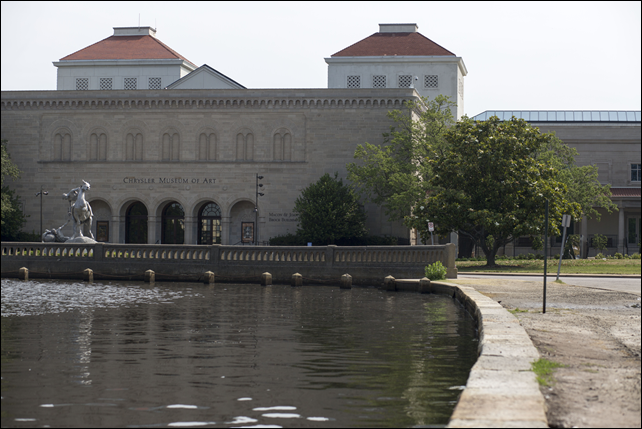In Norfolk, evidence of global warming is in the streets at high tide – ‘We don’t like being the poster child for climate change’
By Lori Montgomery
31 May 2014 NORFOLK (Washington Post) – At high tide on the small inlet next to Norfolk’s most prestigious art museum, the water lapped at the very top of the concrete sea wall that has held it back for 100 years. It seeped up through storm drains, puddled on the promenade and spread, half a foot deep, across the street, where a sign read, “Road Closed.” The sun was shining, but all around the inlet people were bracing for more serious flooding. The Chrysler Museum of Art had just completed a $24 million renovation that emptied the basement, now accessible only by ladder, and lifted the heating and air-conditioning systems to the top floor. A local accounting firm stood behind a homemade barricade of stanchions and detachable flaps rigged to keep the water out. And the congregation of the Unitarian Church of Norfolk was looking to evacuate. “We don’t like being the poster child for climate change,” said the Rev. Jennifer Slade, who added that the building, with its carved-wood sanctuary and soaring flood-insurance rates, would soon be on the market for the first time in four decades. “I don’t know many churches that have to put the tide chart on their Web site” so people know whether they can get to church. On May 6, the Obama administration released the third National Climate Assessment, and President Obama proclaimed climate change no longer a theory; its effects, he said, are already here. This came as no surprise in Norfolk, where normal tides have risen 11 / 2 feet over the past century and the sea is rising faster than anywhere else on the East Coast. The more urgent question is what to do about it — and how to pay for it. For that, the White House has offered few answers.Focused for much of his presidency on a politically contentious campaign to slow global warming by reducing carbon emissions, Obama has turned only recently to the matter of preparing the nation for effects that scientists say already are inevitable. Last year, the Government Accountability Office added climate change to its “high-risk” list, declaring that the lack of planning poses “significant financial risks” to the federal government, which funds flood and crop insurance, pays for disaster relief and owns hundreds of facilities exposed to rising seas. Obama has ordered every agency to start planning for climate change, but administration officials acknowledge that the process is in its infancy. Meanwhile, there is no new money to help hard-hit places such as Norfolk, where residents are clamoring for relief. Norfolk exists because of the sea. Ships have been built in its harbors since the Revolutionary War. It is home to the largest naval base on the globe. Bounded by the Chesapeake Bay and two rivers, sliced by coastal creeks, Norfolk has always been vulnerable to flooding. But over the past decade, people began noticing alarming trends. Hurricanes and nor’easters became more frequent and more damaging. Even ordinary rainstorms swamped intersections, washed away parked cars and marooned the region’s major medical center. Before 1980, the inlet near the Chrysler Museum, known as the Hague, had never flooded for more than 100 hours in a year. By 2009, it was routinely flooded for 200 and even 300 hours a year. The city hired a Dutch consulting firm to develop an action plan, finalized in 2012, that called for new flood gates, higher roads and a retooled storm water system. Implementing the plan would cost more than $1 billion — the size of the city’s entire annual budget — and protect Norfolk from about a foot of additional water. As the city was contemplating that enormous price tag, the Virginia Institute of Marine Science (VIMS) last year delivered more bad news: If current trends hold, VIMS scientists said, by the end of this century, the sea in Norfolk would rise by 51 / 2 feet or more. “Clearly, we’ve got more work to do,” said Ron Williams Jr., Norfolk’s assistant city manager for planning. [more]
In Norfolk, evidence of climate change is in the streets at high tide
